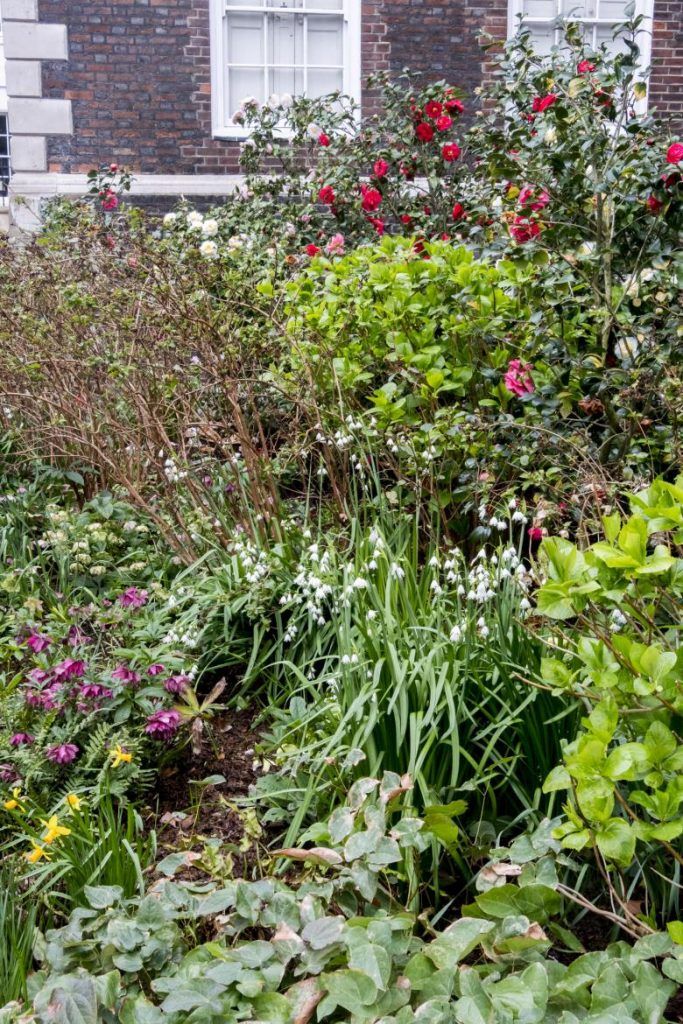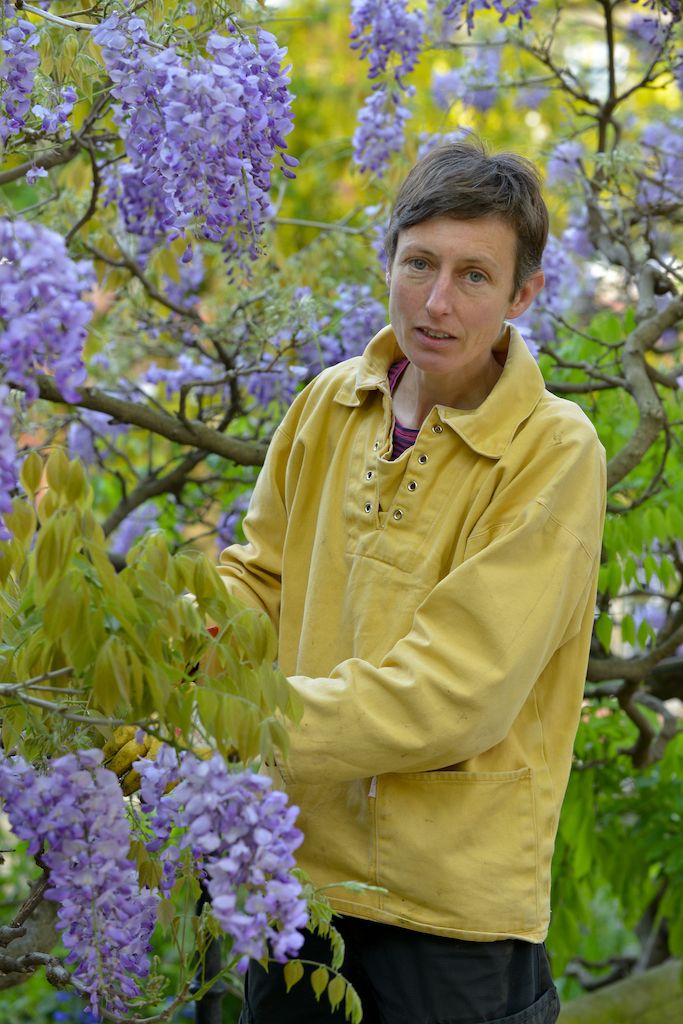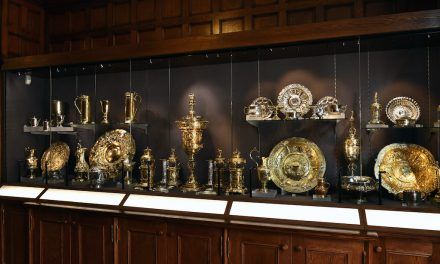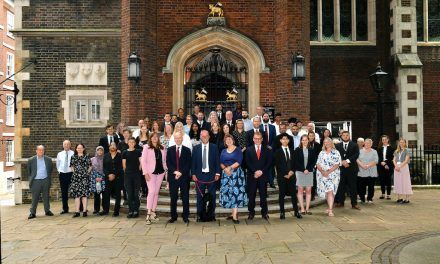At the moment, the post of Master of the Garden is something of a sinecure. Due to Covid-19, the main garden, usually open to allcomers from May to September, has had to be kept closed and the many Inn activities that take place in the gardens, from weddings to the Inn’s glorious annual Garden Party, have not been taking place. Not that these are the responsibility of the Master of the Garden; they are in the capable hands of the Inn’s usual competent staff.
Kate Jenrick, the Inn’s Head Gardener, who has been with the Inn for more than ten years, is responsible with some part-time help for the organisation of the main garden, (the terrace garden and large lawn used for functions) with a smaller garden in Elm Court and the relatively new vegetable parterre in Church Court, behind the Temple church, which was the idea of Kate and a member of her team. It is as decorative as it is useful and has won two awards, including a Best in Show Award from the City in Bloom competition run by the Worshipful Company of Gardeners. Kate is a multiple prize winner. The beautiful winter garden, filled with snowdrops, narcissi, hellebores and camellias, which lift one’s spirits as one walks through Fountain Court on a drab day in winter, very deservedly won the Cutler Trophy for winter colour awarded by the Worshipful Company of Gardeners this year. This award is only one of several; we also have Gold Awards for the main garden and for Elm Court.

All that the Master of the Garden has to do with these award ceremonies is to join in the festivities and clap. There are other pleasant activities. In the autumn, the Master of the Garden helps to choose the tulips which give us such a spectacular display every springtime and to join the group of volunteers that helps Kate to get them planted. The garden also participates in the annual London Open Gardens Squares Festival with garden tours led by Kate and teas with homemade cakes. The money raised is shared by the Library and charities. Although sadly the Festival could not be held this year, a film was substituted in which Kate featured with lovely photos of our gardens in winter.
The Temple Gardens are very ancient and have historical importance. Their origin is medieval, when they were probably used to grow vegetables and trees were planted, including elms and fruit trees, today replaced with London planes. There must also have been some flowers, if we are to believe the legendary picking of white and red roses in the Temple Gardens as emblems by the York and Lancaster factions. Between 1611-16, a knot garden was planted, in keeping with the Tudor architecture of the Hall. Traditionally knot gardens had box borders which were planted with low flowers, such as pansies, germanders (speedwell) and pinks, as we were told by Dr Paula Henderson in a talk to the Middle Temple Historical Society (‘The Gardens of the Early Inns of Court’, available online). Fountain Court was formed in 1681-82, when fountains giving clean water were very much in fashion, though its two mulberry trees are disappointingly not so old – probably Victorian. The gardens were reshaped in 1720 and again in 1870, after the Thames was banked in, doubling the area of the Middle Temple Garden.
The Temple gardens have a social and ecological importance. They form a key part of London’s green space. On his website, landscape Architect Dominic Cole describes the Temple gardens as ‘one of London’s oldest (continuously) surviving gardens’ and, as Dr Henderson emphasised in her lecture, the survival of the four Inn gardens is in stark contrast to surrounding areas of the city, which have been steadily built up and have eaten away the previous green space. It is therefore important to maintain public access to the gardens and to retain some historical resonance. Red and white roses are still grown in a bed at the bottom of the garden and we keep a simplified knot garden alongside the Hall, resplendent with pink bakeri tulips in early spring.

Over the centuries, the Temple has seen many changes, and is likely in the future to see many more; indeed, this is a time of considerable change. The garden must play its part in the Inn’s changing activities. It must continue to be relevant and serve the strategic aims of the Inn. But the Inn must be mindful of the garden’s own function to provide a restful green space. In this respect, the Master has essential communicative functions. The Inn may, for example, need more space for teaching or a set of chambers may apply to the Estates Committee to expand but it would be wrong to allow too much encroachment on the green space of the garden. Health and safety requires an additional fire exit in Hall but we should not let this be used as a general path through the garden. Requests to memorialise the garden (of which we receive many) must be resisted; this is not a garden of rest.
It is vital for the impact of the Inn’s activities on the garden to be borne in mind by the Inn’s decision-makers. It is important too to consider the long-term implications of decisions – small saplings grow into big trees, which may be badly selected or situated and have to be cut down at great expense in the future. In such matters, it is the function of the Master of the garden to act as a channel of communication between the garden staff and senior members of the Inn and to communicate their views. The Master is, for this purpose, a member of the Estates Committee, has access to other committees and senior members of the Inn and can of course speak up for the garden in Parliament. In short, the Master is the guardian of the garden with the duty to make sure that it is properly tended.

Master Carol Harlow is Emeritus Professor of Law at the London School of Economics. She was appointed Queen’s Counsel (honoris causa) in 1996 and a Bencher of the Middle Temple in 2009, where she is Master of the Garden, is an active Scholarship Interviewer and was Lent Reader 2019.

Kate Jenrick has worked in a wide variety of settings from private gardens to public squares and parks. She went on to obtain a Horticultural Diploma from Kew. After working at Kew, she started a short stint at Painshill Park and worked in East London for a social enterprise landscape and design company which encompassed some horticultural teaching in schools.




